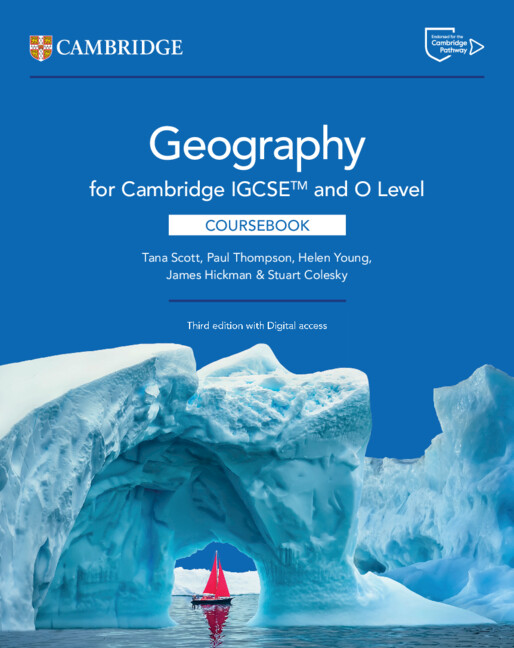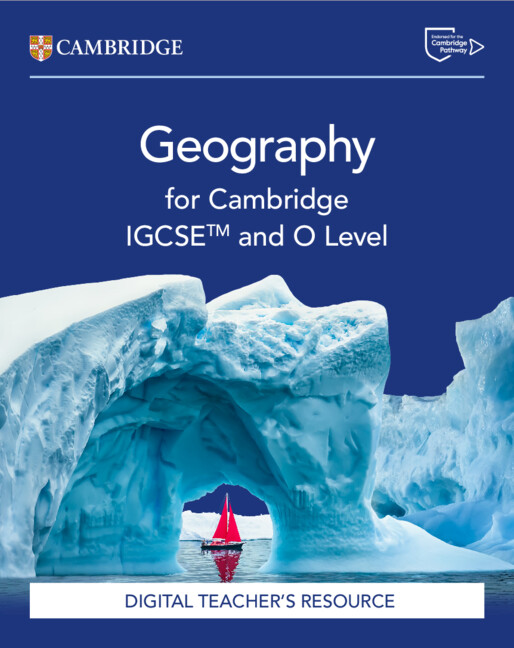We have fully updated this digital coursebook to support the Cambridge IGCSE™ , IGCSE (9-1) and O Level Geography syllabuses (0460/0976/2217) for examination from 2027. With a skills-based approach throughout, our coursebook now includes a dedicated chapter on climate change, a 'Think like a geographer' feature to help students apply their skills to a variety of real-life events, group project activities and more. There are also many opportunities to help students prepare for assessment with practice questions, tasks and a dedicated 'Preparing for assessment' chapter. Access your digital resource via Cambridge GO.
Features
- Takes a skills-based approach throughout, with a new geographical enquiry section to help develop fieldwork skills.
- Dedicated climate change chapter explores causes and effects of climate change through a variety of engaging learning features and activities to strengthen understanding.
- Detailed specific examples focus on regional events, with additional videos in each topic, which help students apply their learning to real-life contexts.
- 'Think like a geographer' feature encourages students to apply their skills to a variety of real-world scenarios.
- Projects help put learning into practice and develop key collaboration skills.
- 'Improve your answer' section within each unit includes analysis on sample answers, why they're effective and areas for improvement.
- A dedicated 'Preparing for assessment' section and practice questions for every topic
- Answers are available for teachers within this digital coursebook and teacher's resource.
- Accessibility Information: This publication meets the requirements of the EPUB Accessibility specification with conformance to WCAG 2.2 Level AA.
Table of Contents
- Table of Contents
- How to use this series
- How to use this book
- Foreword Liam Saddington and Amy Munro-Faure
- Introduction
- Introduction to command words
- Geographical Skills
- Theme 1: Physical Geography
- Topic 1 Rivers
- 1.1 Rivers and drainage basins
- 1.2 River processes
- 1.3 River landforms
- 1.4 Hazards, opportunities and management
- 1.5 Detailed specific example: The Mississippi River, USA
- 1.6 Detailed specific example: The Citarum River, Indonesia
- Topic 2 Coastal environments
- 2.1 How physical processes shape the coast
- 2.2 Coastal landforms
- 2.3 Opportunities and challenges of living near coasts
- 2.4 Detailed specific example: Florida, USA
- 2.5 Detailed specific example: The Great Barrier Reef, Australia
- Topic 3 Ecosystems
- 3.1 Characteristics of the Antarctic ecosystem
- 3.2 Management of threats to the Antarctic ecosystem
- 3.3 Characteristics of the tropical rainforest ecosystem
- 3.4 Management of threats to tropical rainforests
- 3.5 Detailed specific example: Ecuador
- Topic 4 Tectonic hazards
- 4.1 The Earth's structure
- 4.2 The processes and features of earthquakes and volcanoes
- 4.3 The impacts of tectonic hazards
- 4.4 The management of tectonic hazards
- 4.5 Detailed specific example: T'rkiye
- 4.6 Detailed specific example: Tonga
- Topic 5 Climate change
- 5.1 Causes of climate change
- 5.2 The effects of climate change
- 5.3 Managing climate change
- 5.4 Detailed specific example: India
- Theme 1 Physical Geography: Practice questions
- Theme 2: Human Geography
- Topic 6 Population change
- 6.1 Population growth and decline
- 6.2 Changing population structures
- 6.3 Detailed specific example: Hungary
- 6.4 Causes and impacts of migration
- 6.5 Detailed specific example: International migration from Mexico to the USA
- Topic 7 Changing towns and cities
- 7.1 Where most people live
- 7.2 Opportunities and challenges of urbanisation 7.3 The management of urban growth 7.4 Detailed specific example: Mumbai, India
- Topic 8 The challenge of development 8.1 Defining and measuring development
- 8.2 Uneven development 8.3 Achieving sustainable development
- 8.4 Detailed specific example: Botswana Topic 9 Economic change
- 9.1 Changing economies
- 9.2 Globalisation 9.3 Detailed specific example: Dubai, UAE
- 9.4 Why is tourism a growing global industry?
- 9.5 Detailed specific example: The Maldives Topic
- 10 Resource management
- 10.1 How our food is produced
- 10.2 Global patterns of food supply and demand
- 10.3 The challenges of food supply
- 10.4 Detailed specific example: Haiti
- 10.5 How our energy is produced
- 10.6: Energy supply and demand
- 10.7 A sustainable energy future
- 10.8 Detailed specific example: Qatar
- Theme 2 Human Geography
- Practice questions
- Geographical Enquiry
- Preparing for assessment
- Glossary
- Acknowledgements
- WCAG v2.2
- WCAG level AA
- Accessibility summary: This publication meets the requirements of the EPUB Accessibility specification with conformance to WCAG 2.2 Level AA.
Advice on useful tools
Advice on useful tools, activities and timetabling from teachers experiencing school closures.
Cambridge GO
All our supporting resources have now moved to Cambridge GO – the new home for your Cambridge digital content.
Listen to our podcast
Listen to our podcast to discover teaching inspiration & advice from leading educational thinkers.





